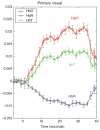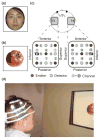fNIRS in the developmental sciences
- PMID: 26263229
- PMCID: PMC4979552
- DOI: 10.1002/wcs.1343
fNIRS in the developmental sciences
Abstract
With the introduction of functional near-infrared spectroscopy (fNIRS) into the experimental setting, developmental scientists have, for the first time, the capacity to investigate the functional activation of the infant brain in awake, engaged participants. The advantages of fNIRS clearly outweigh the limitations, and a description of how this technology is implemented in infant populations is provided. Most fNIRS research falls into one of three content domains: object processing, processing of biologically and socially relevant information, and language development. Within these domains, there are ongoing debates about the origins and development of human knowledge, making early neuroimaging particularly advantageous. The use of fNIRS has allowed investigators to begin to identify the localization of early object, social, and linguistic knowledge in the immature brain and the ways in which this changes with time and experience. In addition, there is a small but growing body of research that provides insight into the neural mechanisms that support and facilitate learning during the first year of life. At the same time, as with any emerging field, there are limitations to the conclusions that can be drawn on the basis of current findings. We offer suggestions as to how to optimize the use of this technology to answer questions of theoretical and practical importance to developmental scientists.
© 2015 John Wiley & Sons, Ltd.
Conflict of interest statement
Conflict of interest: The authors have declared no conflicts of interest for this article.
Figures










References
-
- Jobsis FF. Noninvasive infrared monitoring of cerebral and myocardial sufficiency and circulatory parameters. Science. 1977;198:1264–1267. - PubMed
-
- Meek JH, Firbank M, Elwell CE, Atkinson J, Braddick O, Wyatt JS. Regional haemodynamic responses to visual stimulation in awake infants. Pediatr Res. 1998;43:840–843. - PubMed
-
- Machery E. In defense of reverse inference. Brit J Phil Sci. 2014;65:251–267. doi: 10.1093/bjps/axs044. - DOI
FURTHER READING
-
- Boas DA, Elwell CE, Ferrari M, Taga G. Twenty years of functional near-infrared spectroscopy: introduction of the special issue. Neuroimage. 2014;85:1–5. - PubMed
-
- Meek J. Basic principles of optical imaging and application to the study of infant development. Dev Sci. 2002;2002:371–380.
Publication types
MeSH terms
Grants and funding
LinkOut - more resources
Full Text Sources
Other Literature Sources
Medical

